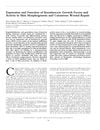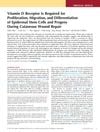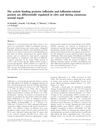Search
forLearn
1 / 1 resultsResearch
5 / 1000+ results
research Expression and Function of Keratinocyte Growth Factor and Activin in Skin Morphogenesis and Cutaneous Wound Repair
KGF and activin are crucial for skin healing and repair.

research The Role of Nuclear Hormone Receptors in Cutaneous Wound Repair
Nuclear hormone receptors play a significant role in skin wound healing and could lead to better treatment methods.

research Vitamin D Receptor Is Required for Proliferation, Migration, and Differentiation of Epidermal Stem Cells and Progeny During Cutaneous Wound Repair
The vitamin D receptor is essential for skin stem cells to grow, move, and become different cell types needed for skin healing.

research The Activin Binding Proteins Follistatin and Follistatin-Related Protein Are Differentially Regulated In Vitro and During Cutaneous Wound Repair
FLRG and follistatin have different roles in wound healing.
research Smooth Muscle Cell Expression of a Constitutively Active Form of Human Profilin1 Accelerates Cutaneous Wound Repair
Profilin1 speeds up wound healing.
Community Join
5 / 15 resultscommunity Androgenetic alopecia is a skin disease: DHT-mediated skin disorders
Dihydrotestosterone (DHT) impacts various skin conditions, including Androgenetic alopecia and seborrheic dermatitis, by causing overactivity in sebaceous glands. Topical medications Tacrolimus and Clobetasol can reduce these inflammatory conditions, and treatments like RU58841, Minoxidil, and Finasteride may also be beneficial.
community New and Interesting HairLoss Studies/Papers/Reviews
Hair loss treatments discussed include Dutasteride with Ketoconazole, tissue engineering strategies, and androgenetic alopecia therapies. Massage doubles follicular retention, improving treatment effectiveness.
community How do you use rosemary oil and peppermint oil?
Rosemary oil and peppermint oil may promote hair growth and increase cutaneous blood flow, showing promise as treatments for androgenetic alopecia. Minoxidil 2% is also used for treating hair loss.
community Scientific evidence for Peppermint & Rosemary oils + My Experience
Natural treatments for hair loss, specifically peppermint oil and rosemary oil; how they can be used as a supplementary or alternative treatment to pharmaceuticals such as finasteride and minoxidil; and the personal experience of the user Divallo, who has seen an increase in density and thickness after using these oils for around 2.5 years. The post also touches on the potential antifungal properties of the oils and their effects on cutaneous blood flow.
community high bloodpressure and crown thinning in early 20s
A user with kidney disease and high blood pressure experienced hair thinning, especially around the vertex. They are currently using finasteride and oral minoxidil but are considering whether to resume blood pressure medication despite managing symptoms with diet and exercise.